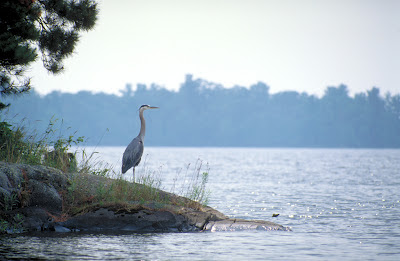“That will allow the federal government to build a new barrier there to keep sea lampreys from breeding in the river. Managers of the fishery expect that will bring the lamprey problem under control in Lake Michigan.”
Category:
In the news: New barrier could help control sea lampreys near Lake Michigan
August 16th, 2012 by Irene MilesIn the news: Federal study to help Great Lakes communities prevent floods
May 21st, 2012 by Irene Miles“Federal officials are studying how to help Great Lakes communities better prepare for hazardous floods.‘It will be the most comprehensive study ever conducted of shoreline flooding,’ said Ken Hinterlong, a senior engineer with the Federal Emergency Management Agency. So far, only ‘…the first phase of the project is done, which is a basin-wide data collection for Lake Michigan and Lake St. Clair.’”
In the news: Further research on Lake Michigan-based wind power
May 15th, 2012 by Irene MilesGLRRIN Lake Michigan partners examine future of Lake Michigan food webs
April 11th, 2012 by Irene MilesThe term “food web” is used to describe the intricate relationships between the many different plants, animals, and organisms that can exist in small or large areas. Understanding food webs in specific environmental locations, such as in one or more of the Great Lakes, can help researchers and communities better respond to changes in those delicate systems. Invasive species are just one example of a potential influence that can drastically alter a food web and have substantial impacts on native environments.
Recent News
- We’re hiring eight interns for summer 2026
- In 2026, IISG intends to fund 10 research projects focused on coastal concerns
- IISG looks back on 30 years of AIS outreach
- New step-by-step guide and veterinary brochures expand UnwantedMeds.org resources
- The Helm magazine features teachers and scientists setting sail on Lake Michigan
IISG Instagram
The gales of November may come early, but, as usual, the nominations for the Lakies are right on time along with our official call for nominations!
Brought to you by the Teach Me About the Great Lakes podcast, The Lakies (aka "quite possibly not the least prestigious Great Lakes-focused awards ceremony there is”) are back.
Our goal isn`t to be the Official Arbiters of Quality, but to host a fun celebration of amazing Great Lakes-related research, outreach, and communication in the inimitable Teach Me style.
Nomination categories are:
-Great Lakes Science Communication of the Year
-Great Lakes Outreach Program of the Year
-Great Lakes News Event of the Year
-Great Lakes Research Finding of the Year
-Coolest Thing You Learned Listening to TMATGL in 2025
-Science Podcast of the Year (Non-TMATGL edition)
-Great Lakes Animal of the Year
-Great Lakes Non-Animal of the Year
-Great Lakes Sandwich of the Year
-Great Lakes Donut of the Year
The Details:
-Deadline: Nominations close on December 4th.
Process: It`s easy (just enter the name/title and a link).
-Self-Nominations: Highly encouraged. Don`t be shy.
We’d love to get a broad swath of work across both the serious and less-serious categories to celebrate. Feel free to pass the link on to interested people: https://bit.ly/Lakies25

Making Sense of Social Media: Presented by Illinois-Indiana Sea Grant & Purdue Extension
When: December 6, 2025, from 1 - 4:00 PM EST
Where: RDM Shrimp, RDM Shrimp, 101 N 850 E, Fowler, IN 47944
Registration Link in bio.
Social media can be a great way to market your small business and products, but sometimes it might feel like you are casting a net again and again to find that your net is empty. After all, the point of using social media marketing is to connect with customers. By attending this workshop, you will:
-Hear Research Findings
-Participate in an Interactive Workshop Session
-Learn Real World Application
-Tour a Shrimp Farm
-Network at the “After Hour Social”
This program is supported by the North Central Regional Aquaculture Center and put on in partnership with the Indiana Aquaculture Association Inc, RDM Shrimp, and Ohio Sea Grant, The Ohio State University.
For questions contact Amy Shambach by email (ashambac@purdue.edu) or phone (317-238-0511)

This fall, our team took advantage of several opportunities to showcase our engaging educational programs at outreach events.
One highlight included the Great Plankton Race, where participants built plankton models and tested various adaptations that help this vital part of the food web survive.

Illinois-Indiana Sea Grant has created another resource for students in the Great Lakes region to engage with real-world, professional water quality testing equipment. Currently, the Know Your H₂O Kit is being pilot tested in five classrooms, and for one Ohio teacher, it’s a hit for her and her students.
“The lessons have been incredibly useful,” said Shari Insley, a science teacher in North Olmsted, Ohio. “They not only aligned well with our Ohio 7th-grade science curriculum but also brought concepts to life in a way that deepened students’ understanding. For many students, this was their first time using scientific tools to test real water samples, and it sparked curiosity about local water systems and environmental stewardship.”
Learn more at the link in bio.

Categories
- Aquaculture
- Aquatic Invasive Species
- Buoys
- Climate Ready Communities
- Coastal Resilience
- Director's Blog
- Education
- Featured
- Fellowships
- Fisheries
- Funded Research
- Funding
- Great Lakes Cleanup
- Great Lakes Data
- Healthy Waters
- Internships
- Jobs
- K-12 Education
- News
- Photos
- Program
- Recreation & Tourism
- Resources
- Sea Grant Scholars
- Stormwater & Green Infrastructure
- Sustainable Community Planning
- The Helm
- Uncategorized
- Video
- Water Resource Economics

